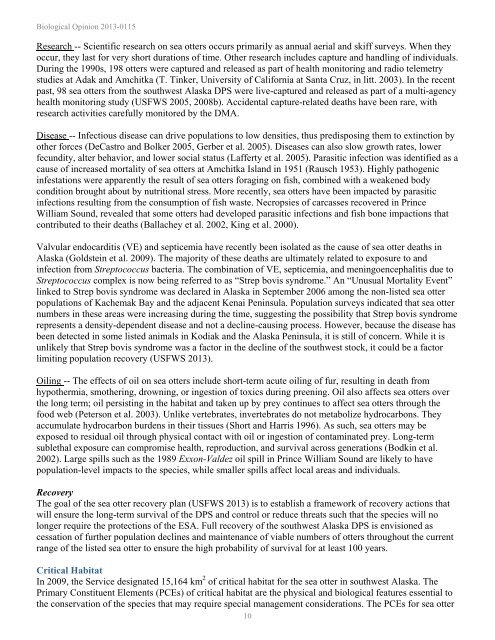United States Department of the Interior - U.S. Fish and Wildlife ...
United States Department of the Interior - U.S. Fish and Wildlife ...
United States Department of the Interior - U.S. Fish and Wildlife ...
You also want an ePaper? Increase the reach of your titles
YUMPU automatically turns print PDFs into web optimized ePapers that Google loves.
Biological Opinion 2013-0115<br />
Research -- Scientific research on sea otters occurs primarily as annual aerial <strong>and</strong> skiff surveys. When <strong>the</strong>y<br />
occur, <strong>the</strong>y last for very short durations <strong>of</strong> time. O<strong>the</strong>r research includes capture <strong>and</strong> h<strong>and</strong>ling <strong>of</strong> individuals.<br />
During <strong>the</strong> 1990s, 198 otters were captured <strong>and</strong> released as part <strong>of</strong> health monitoring <strong>and</strong> radio telemetry<br />
studies at Adak <strong>and</strong> Amchitka (T. Tinker, University <strong>of</strong> California at Santa Cruz, in litt. 2003). In <strong>the</strong> recent<br />
past, 98 sea otters from <strong>the</strong> southwest Alaska DPS were live-captured <strong>and</strong> released as part <strong>of</strong> a multi-agency<br />
health monitoring study (USFWS 2005, 2008b). Accidental capture-related deaths have been rare, with<br />
research activities carefully monitored by <strong>the</strong> DMA.<br />
Disease -- Infectious disease can drive populations to low densities, thus predisposing <strong>the</strong>m to extinction by<br />
o<strong>the</strong>r forces (DeCastro <strong>and</strong> Bolker 2005, Gerber et al. 2005). Diseases can also slow growth rates, lower<br />
fecundity, alter behavior, <strong>and</strong> lower social status (Lafferty et al. 2005). Parasitic infection was identified as a<br />
cause <strong>of</strong> increased mortality <strong>of</strong> sea otters at Amchitka Isl<strong>and</strong> in 1951 (Rausch 1953). Highly pathogenic<br />
infestations were apparently <strong>the</strong> result <strong>of</strong> sea otters foraging on fish, combined with a weakened body<br />
condition brought about by nutritional stress. More recently, sea otters have been impacted by parasitic<br />
infections resulting from <strong>the</strong> consumption <strong>of</strong> fish waste. Necropsies <strong>of</strong> carcasses recovered in Prince<br />
William Sound, revealed that some otters had developed parasitic infections <strong>and</strong> fish bone impactions that<br />
contributed to <strong>the</strong>ir deaths (Ballachey et al. 2002, King et al. 2000).<br />
Valvular endocarditis (VE) <strong>and</strong> septicemia have recently been isolated as <strong>the</strong> cause <strong>of</strong> sea otter deaths in<br />
Alaska (Goldstein et al. 2009). The majority <strong>of</strong> <strong>the</strong>se deaths are ultimately related to exposure to <strong>and</strong><br />
infection from Streptococcus bacteria. The combination <strong>of</strong> VE, septicemia, <strong>and</strong> meningoencephalitis due to<br />
Streptococcus complex is now being referred to as “Strep bovis syndrome.” An “Unusual Mortality Event”<br />
linked to Strep bovis syndrome was declared in Alaska in September 2006 among <strong>the</strong> non-listed sea otter<br />
populations <strong>of</strong> Kachemak Bay <strong>and</strong> <strong>the</strong> adjacent Kenai Peninsula. Population surveys indicated that sea otter<br />
numbers in <strong>the</strong>se areas were increasing during <strong>the</strong> time, suggesting <strong>the</strong> possibility that Strep bovis syndrome<br />
represents a density-dependent disease <strong>and</strong> not a decline-causing process. However, because <strong>the</strong> disease has<br />
been detected in some listed animals in Kodiak <strong>and</strong> <strong>the</strong> Alaska Peninsula, it is still <strong>of</strong> concern. While it is<br />
unlikely that Strep bovis syndrome was a factor in <strong>the</strong> decline <strong>of</strong> <strong>the</strong> southwest stock, it could be a factor<br />
limiting population recovery (USFWS 2013).<br />
Oiling -- The effects <strong>of</strong> oil on sea otters include short-term acute oiling <strong>of</strong> fur, resulting in death from<br />
hypo<strong>the</strong>rmia, smo<strong>the</strong>ring, drowning, or ingestion <strong>of</strong> toxics during preening. Oil also affects sea otters over<br />
<strong>the</strong> long term; oil persisting in <strong>the</strong> habitat <strong>and</strong> taken up by prey continues to affect sea otters through <strong>the</strong><br />
food web (Peterson et al. 2003). Unlike vertebrates, invertebrates do not metabolize hydrocarbons. They<br />
accumulate hydrocarbon burdens in <strong>the</strong>ir tissues (Short <strong>and</strong> Harris 1996). As such, sea otters may be<br />
exposed to residual oil through physical contact with oil or ingestion <strong>of</strong> contaminated prey. Long-term<br />
sublethal exposure can compromise health, reproduction, <strong>and</strong> survival across generations (Bodkin et al.<br />
2002). Large spills such as <strong>the</strong> 1989 Exxon-Valdez oil spill in Prince William Sound are likely to have<br />
population-level impacts to <strong>the</strong> species, while smaller spills affect local areas <strong>and</strong> individuals.<br />
Recovery<br />
The goal <strong>of</strong> <strong>the</strong> sea otter recovery plan (USFWS 2013) is to establish a framework <strong>of</strong> recovery actions that<br />
will ensure <strong>the</strong> long-term survival <strong>of</strong> <strong>the</strong> DPS <strong>and</strong> control or reduce threats such that <strong>the</strong> species will no<br />
longer require <strong>the</strong> protections <strong>of</strong> <strong>the</strong> ESA. Full recovery <strong>of</strong> <strong>the</strong> southwest Alaska DPS is envisioned as<br />
cessation <strong>of</strong> fur<strong>the</strong>r population declines <strong>and</strong> maintenance <strong>of</strong> viable numbers <strong>of</strong> otters throughout <strong>the</strong> current<br />
range <strong>of</strong> <strong>the</strong> listed sea otter to ensure <strong>the</strong> high probability <strong>of</strong> survival for at least 100 years.<br />
Critical Habitat<br />
In 2009, <strong>the</strong> Service designated 15,164 km 2 <strong>of</strong> critical habitat for <strong>the</strong> sea otter in southwest Alaska. The<br />
Primary Constituent Elements (PCEs) <strong>of</strong> critical habitat are <strong>the</strong> physical <strong>and</strong> biological features essential to<br />
<strong>the</strong> conservation <strong>of</strong> <strong>the</strong> species that may require special management considerations. The PCEs for sea otter<br />
10
















